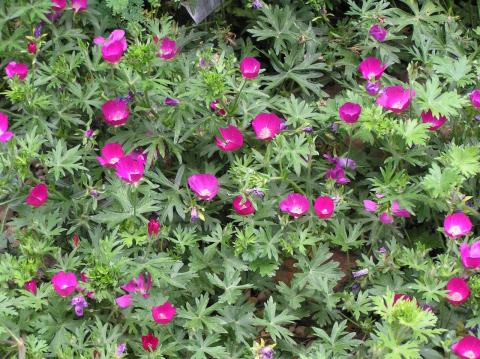
High Plains Gardening
The gardening website of the Texas High Plains Region
To celebrate our local botanic heritage, consider converting a bit of your landscape into a native plant garden. Not only will it look great from April through October with near continuous bloom, native plant gardens are eco-friendly. To sustain the robust bloom power, simply irrigating an inch of moisture a month during the growing season, if that amount isn't received normally, is all these plants require to perform superbly.
Most people think the Texas Panhandle is a wasteland when it comes to wildflowers, or heaven forbid, plants one would not invite and nurture in one's garden. I contend the Texas Panhandle has many, many valuable wildflowers begging to be treasured garden plants. With just minimal soil amending, no fertilizing, no herbicides or pesticides, a native plant garden is an ingenious choice. And, as natives, they attract bees and butterflies to your garden by offering them food and habitat.
Here are my top performers for a native plant garden composed of local, native wildflowers. These are only a few of the many local native wildflowers suitable for Texas Panhandle gardens. This list is composed of only the basics, and not of some of the color variations or varieties also found in nature, though in lesser quantities. Today, I'm concentrating on flowering herbaceous plants that are available from seed or the plants themselves at native plant nurseries and seed houses. Stay tuned for shrubs, grass and cacti that will add diversity in height, width and form.
Berlandiera lyrata, Chocolate Flower. Perennial wildflower with deep tap root forms neat rosette. Dissected gray-green leaves. Yellow daisy flowers with maroon centers emerge on wiry stems from spring into fall with a deep chocolate fragrance, especially notable in the morning. Flowers close by mid day during the hottest part of summer.
 Callirhoe involucrata, winecup. Spreading groundcover with wine colored flowers spring into summer, again in the fall, moisture permitting. Interesting fingered, lobed deep green leaves.
Callirhoe involucrata, winecup. Spreading groundcover with wine colored flowers spring into summer, again in the fall, moisture permitting. Interesting fingered, lobed deep green leaves.
Calylophus hartweggii, Western primrose, Hartweg evening primrose or sundrops. A local native and profuse bloomer from spring into fall, especially with once a month irrigation. Masses of yellow four-petaled flowers on a multitude of thin, wiry branches, so tight they form a mound. As each individual flower lasts only a day, this is a heavy producer. Spent flowers are orange which provides a nice contrast and interest. Soils with good drainage.
Coreopsis tinctoria, plains or painted coreopsis. Late summer blooming with yellow daisy-like flowers with red-brown centers. The plant will reach a height of 2-3 feet, best planted in swales as it needs a micro-niche with a little bit more moisture.
Echinacea angustifolia, purple coneflower. Purple flowers with drooping petals and central dome or disk of deep purple/red/brown hue emerge in May and June from long stems 12-20 inches tall from a cluster of leaves at the base. Prefers dry, rocky and well drained soils.
Engelmannia pinnatifida, Engelmann's daisy, herbaceous perennial with yellow daisy-like flowers April through October. On hot, sunny afternoons, the flower petals will curl under their tips. Can grow to 2-2 ½ feet tall. If too tall for your location, cut down and it will readily grow back, but to a more manageable height. Not particular about soil, readily self seeds.
Gaillardia aristata, Many varieties of blanket flower, perennial, blooms from mid spring on and off into fall. One of our showiest native wildflower.
Ipomea leptophylla, bush morning glory. Non-vining herbaceous perennial with deep taproot. Summer blooming with huge pink flowers. Won't emerge from soil in the spring until it warms. Prefers sandy, rocky, gravely soil. Locally native and through out areas of the Great Plains.
Liatris punctata, gayfeather. 18” x 18”. Purple flowers in September and October. Flower spike emerges from a mound of grass-like leaves. Tap rooted perennial, prefers well-drained soil. Local native and widespread.
Melapodium leucanthum, Blackfoot Daisy, small mounding, sometimes short lived herbaceous perennial with small white daisy-like flowers. Delicate looking, yet surprisingly tough. Will self seed.
Mirabilis multiflora, Desert Four O'clock, spreading herbaceous perennial 12' tall x 6 feet wide. Spring to fall blooming magenta trumpet shaped flowers. Flowers are open in early morning, close then open again in the late afternoon.
Oenothera macrocarpa, Missouri evening primrose. Dark green leaves with large chaliced shaped deep yellow flowers on red stems spring and summer. The spent flower closes into a pretty orange color. Each flower blooms for a day, closes by mid-day heat. A sprawling herbaceous perennial. Flowers develop attractive seed capsules. Can grow in the worst soil, but also in average garden soil. Prefers good drainage. Outside the the Panhandle, Missouri evening primrose is known as Oenothera missouriensis.
Psilostrophe tagetina, paper flower, cut gray-green leaves produce masses of deep yellow flowers from spring into fall that dries to a light yellow-tan. Native perennial for long color value.
Ratibida columnifera, Mexican Hat, red and yellow varieties. Sunflower like flower with elongated conical disk and drooping ray petals. Short lived but reseeds quite freely.
Sphaeralcea coccinea, other species are S. ambigua, S. grossulariifloria, Scarlet, desert globemallow and gooseberry globemallow respectively. S. coccinea may be invasive. It better to use S. ambigua and S. grossulariifloria for the garden. Long season of bloom.
Verbena bipinnitifida, or V. goodingii, prairie verbena. Perennial, short-live perennial that readily self seeds. Small lavender blue to purplish flowers produced from spring into fall.
Zinnia grandiflora, prairie zinnia. No care, low growing and spreading. Yellow flowers continuous spring to fall.
Angie Hanna, May 7, 2013